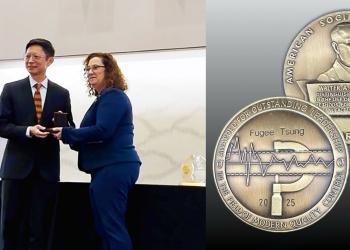HKUST's Novel Gene Discovery Paves the Way for Treating Central Nervous System Injuries
(This article was originally published on EurekAlert! on October 22, 2024)
A collaborative study in neuroscience, spearheaded by a research team of the Hong Kong University of Science and Technology (HKUST), sheds light on new possibilities for treating central nervous system (CNS) injuries, as published in PNAS*. Through the discovery of a novel gene that regulates the regeneration of multiple types of CNS axons, researchers have achieved a significant stride towards repairing damaged neural networks.
The inability of the adult mammalian CNS to repair itself is a major challenge in treating injuries like spinal cord damage, often resulting in permanent disabilities such as paralysis. An initial study conducted by Prof. Kai LIU’s group from the Division of Life Science at HKUST revealed that lipin1 is crucial for regulating axon regeneration by influencing lipid metabolism in neurons, which was published in Neuron in 2019. However, further research is needed to fully understand the complex mechanisms of axon regeneration and how they can be utilized for spinal cord injury treatments. Lipin1 is an enzyme that, when inhibited in retinal ganglion cells, promotes nerve repair by shifting lipid synthesis from storage lipids to phospholipids, while also producing signaling lipids like phosphatidic acid (PA) and lysophosphatidic acid (LPA). These lipids activate crucial cellular pathways, including the mTOR pathway, which is essential for cell growth and survival.
In this new research, the research team led by Prof. Kai Liu designed a novel shRNA targeting lipin1 mRNA and encapsulated it in an AAV vector for delivery to neurons, which can reduce lipin1 level by 63%. They found that reducing lipin1 levels in neurons increased the amount of PA and LPA, leading to increased activation of mTOR and another signaling molecule called STAT3. These changes significantly boosted nerve regeneration. This discovery suggests that a feedback loop involving lipin1-PA/LPA-mTOR plays a key role in preventing nerve regeneration after injury.
Spinal cord injuries are a devastating condition with limited treatment options. While Pten has been identified by researchers in recent decades as a potent target for promoting axon regeneration, its role as a tumor suppressor complicates clinical application, prompting the ongoing search for new therapeutic strategies. The corticospinal tract (CST) is a bundle of nerve fibers that connects the brain to the spinal cord, controlling fine motor skills. Using a rigorous complete spinal cord injury model, the researchers demonstrated that lipin1 knockdown (KD) promotes robust CST axon regeneration (Figure 2). Surprisingly, the regenerative effect of lipin1 KD is comparable, if not superior, to that of Pten deletion. To determine if lipin1 KD could also promote regeneration in other spinal tracts, the researchers examined the regeneration of ascending sensory axons and found that lipin1 KD also significantly enhanced the regeneration of these sensory axons.

Furthermore, this recent study reveals that inhibiting lipin1 not only alters lipid metabolism within neurons but also activates mTOR and STAT3 signaling pathways through PA and LPA, ultimately determining the ability of CNS axons to regenerate (Figure 3). This research identifies lipin1 as a conserved target that controls axon regeneration in multiple contexts, offering a promising new avenue for repairing spinal cord injuries.

This research was a collaborative effort between teams led by Prof. Kai Liu at HKUST, Prof. Zhongping YAO at The Hong Kong Polytechnic University, HKUST President Prof. Nancy IP and Division of Life Science Prof. Amy FU, and Prof. Jacque IP at The Chinese University of Hong Kong.
The study was supported by grants from the Hong Kong Areas of Excellence (AoE) Scheme by Research Grant Council, Innovation and Technology Commission, Health and Medical Research Fund, National Natural Science Foundation of China, Guangzhou Key Projects of Brain Science and Brain-Like Intelligence Technology, Shenzhen-Hong Kong Institute of Brain Science-Shenzhen Fundamental Research Institutions, Nan Fung Life Sciences, and Guangdong Natural Science Foundation.
*Note: Dr. Weitao CHEN, a postdoctoral fellow at Shenzhen PKU-HKUST Medical Centre, Junqiang WUu, a PhD student at HKUST, and Dr. Chao YANG, a postdoctoral fellow at HKUST, are the co-first authors of this paper. Prof. Kai Liu at HKUST is the corresponding author.












